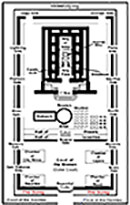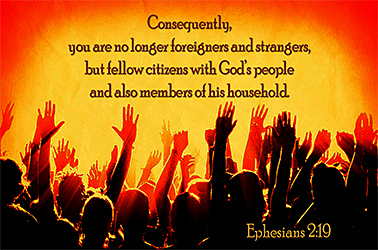
Ephesians 2:11–22 . . .
“Man’s Guilt, God’s Grace”
Today’s twelve-verse text is an extension of what Paul had taught in the first ten verses of chapter 2. (See its highlights in my previous commentary titled “Made Alive by God’s Grace.”) Both passages have a similar structure with each having three divisions: (1) what we were in the past; (2) what Christ has accomplished; (3) the goal or result of his work. In addition to their similarities, we quickly find in vv. 1–10 and vv. 11–22 a most significance theme: Christian unity without hostility.
Comparing both passages closely, we clearly see that Paul highlights God’s reconciliation between himself and fallen man through Jesus Christ in 2:1–10. However, in 2:11–22, the apostle calls attention to the reconciliation that God has achieved between Jews and non-Jewish Gentiles, also through the work of Jesus. Father God has reconciled us to him and to Jewish believers in Christ so everyone can effectively appreciate the essence of Christian unity.
Jews and Gentiles Reconciled (2:11–13)
Apostle Paul will begin today’s passage by introducing to the readers of his apparant circular letter the privileges that will result from God’s mercy when he calls them into his kingdom. Paul endeavors to impress their minds strongly with a sense of God’s mercy, love, and power when he calls them to himself.
One in Christ
11Therefore, remember that formerly you who are Gentiles by birth and called “uncircumcised” by those who call themselves “the circumcision” (which is done in the body by human hands) — 12remember that at that time you were separate from Christ, excluded from citizenship in Israel and foreigners to the covenants of the promise, without hope and without God in the world. 13But now in Christ Jesus you who once were far away have been brought near by the blood of Christ (Ephesians 2:11–13 NIV).
In effect, Paul is telling his Ephesian church body readers not to take for granted what he’s telling them. After all, it seemed to him to have only been yesterday when those who’d been outsiders to God’s ways had absolutely no understanding of any of this. Neither did they know the first thing about how God works, anything about Christ or the rich history of God’s covenants and promises in Israel, or what God was doing in the world.
It’s wise for Christians to “remember” what they were. No faculty of the mind can be better employed to produce humility, penitence, gratitude, and love, than memory. It’s wise to recall our former sins, dwelling on our hardness of heart, alienation, and unbelief; we need to also remember our wanderings and guilt. The converted Ephesians had quite a lot of guilt in their former life to recollect and mourn over; so too does every convert to the Christian faith.
The use of the phrase “who call themselves ‘the circumcision’” — comes with a touch of the contempt implied when we refer to something as “so-called.” Paul is simply implying that now “circumcision” and “uncircumcision” were mere names, virtually lacking value or importance.
Verse 12 sums up, in Paul’s terms, what it meant to be an unbelieving Gentile. It gives a dark and terrible picture of the Ephesians’ former heathen condition, intentionally contrasting the description of Christian privilege that Paul will emphasize in vv. 19–20. That pagan condition is first summed up in one expression: They were “separate from Christ.” Paul then draws two gloomy consequences: (1) they had no part in God’s special covenant, being “excluded from citizenship in Israel” and “foreigners to the covenants of the promise” of the Messiah; (2) while left “in the world,” they were “without hope” of spiritual life and immortality, “without God” in mind and action (v. 12).
It comes as no surprise to the Christian that when one has faith in Jesus Christ, he or she has a new beginning and becomes something new and different. Paul says just that in 2 Corinthians 5:17 in which old things pass away and new things are created. What he speaks of individually in that verse, he speaks of corporately in vv. 12–13. Herein, Paul tells us that Jews and Gentiles who’d been “far away” but chose to believe in Christ have been “brought near,” alowing them to lose their “Jewishness” and “Gentileness” and be formed into one new unified entity: the church.
Behold: New Things Have Come (2:14–18)
We know that when our Lord died on Calvary’s cross, the temple’s veil was split from top to bottom (Matthew 27:51), symbolizing the fact that the barrier between man and God had been removed. The wall existed between Jews (God’s chosen people) and Gentiles (all other people). It was also symbolized by the dividing wall (the soreg) in the ancient temple erected by Herod the Great in Jerusalem. It kept Gentiles from entering beyond the outer courts of the temple. But Jesus brought peace and reconciliation between the Jews and Gentiles when he “destroyed the barrier, the dividing wall of hostility… thus making peace.”
Paul adds that the wall that separated Jewish believers from Gentile believers has also been destroyed. It was Jesus who united both groups when he destroyed the dividing wall’s barrier “by setting aside in his flesh” the ongoing cultural and religious conflicts brought about for the generations and ultimately caused by “the law with its commands and regulations” (vv. 14–15a). The good news of “peace” made it possible for all to be united by faith in Christ (vv. 17–18).
14For he himself is our peace, who has made the two groups one and has destroyed the barrier, the dividing wall of hostility, 15by setting aside in his flesh the law with its commands and regulations. His purpose was to create in himself one new humanity out of the two, thus making peace, 16and in one body to reconcile both of them to God through the cross, by which he put to death their hostility. 17He came and preached peace to you who were far away and peace to those who were near. 18For through him we both have access to the Father by one Spirit (Ephesians 2:14–18 NIV).
In Paul’s view, Jesus “himself, is our peace” (v. 14). He hasn’t simply made peace between God and man but has united Jew and Gentile. Jesus is our peace! Today, many things can divide us. As God provides what we need, let’s strive to live out the peace and unity found in and through Jesus (vv. 19–22).
This new unity that Father God accomplished through his Son on the cross of Calvary is described here in several ways by Apostle Paul. First, all believers are one because they’re saved in the same way, through the same person, Jesus Christ. Jews and Gentiles are saved by obtaining a new identity in Christ. Second, when reconciled to God, Jews and Gentiles are reconciled as “one new humanity” (v. 15) created anew as “one body” (v. 16a). Third, when Christ came to earth, he preached the same message of peace to the Jews “who were near” and Gentiles “who were far away” (v. 17). Fourth, Jewish and Gentile believers in Jesus become united as one, since both groups have identical “access to the Father by one Spirit” — the Holy Spirit (v. 18).
Looking at v. 15a’s reference to “setting aside in [Jesus’] flesh the law with its commands and regulations,” we see the origin of contention between Jew and Gentile: Gentiles didn’t keep the law. But since Jesus fulfilled the law on everyone’s behalf, and since he bore the penalty for our failure to keep the law, harmony is restored between Jew and non-Jew through what he accomplished for us on the cross… putting to death the causes of contention.
Gentiles and Jews, then and today, are brought together to become one body, the church (v. 16a), wherein our unity in Jesus far exceeds our differences. And, when Paul adds to that verse, “to reconcile both of them to God through the cross,” he emphasizes Jesus’ work on the cross by repeating its essence many times: “brought near by the blood” (v. 13); having abolished in his flesh the “the dividing wall of hostility” torn down by Jesus (v. 14b); and, “in one body to reconcile both of them to God through the cross” (v. 16a). This unity didn’t happen on its own; it was the result of a hard-fought accomplishment of Jesus.
The text of v. 18 documents the collaborative performances of the holy Trinity: Jews and Gentiles are to be presented to Father God; his Spirit works in their hearts, preparing them for this presentation; and Jesus Christ introduces everyone, whether near or far.
Members of God’s Household (2:19–22)
Paul next assures his readers of the fact that they’re no longer wandering exiles since Christ had preached peace to the insiders and outsiders, treating everyone as equals who each share the same Holy Spirit and have equally unbridled access to Father God.
19Consequently, you are no longer foreigners and strangers, but fellow citizens with God’s people and also members of his household, 20built on the foundation of the apostles and prophets, with Christ Jesus himself as the chief cornerstone. 21In him the whole building is joined together and rises to become a holy temple in the Lord. 22And in him you too are being built together to become a dwelling in which God lives by his Spirit (Ephesians 2:19–22 NIV).
As we read these four closing verses, we can almost feel Paul’s emotion and conviction, as if he were telling his Jewish and non-Jewish readers: “You belong here, with as much right to the name “Christian” as anyone. God is building a home for all of you, using us all, irrespective of how we got here, in what he’s building. Initially, he used the apostles and prophets to build the house’s foundation. Now he’s using you, fitting you in, brick by brick, stone by stone, with Christ Jesus as the cornerstone who holds all the parts together. You can see it taking shape, day after day. It’s a holy temple built by God, with all of us built into it and where God is quite at home.”
Clearly, these verses sum up the two-fold theme of chapter 2 — the union made up of Gentiles, God, and God’s chosen people. Paul handily illustrates one essential concept when he introduces to us the metaphor of One Temple: Jesus Christ is the building’s/temple’s/church’s chief cornerstone. As such, this unified structure or organization, whether collectively or individually, grows into a holy house of God.
That “chief cornerstone of the church” metaphor is drawn, of course, from Psalm 118:22, which our Lord applied to himself in Matt. 21:42–44. Using that illustrative word picture, Paul likely proposes a massive cornerstone in which the two main walls of a foundation meet and get bonded together in perfect squareness.
Paul’s closing verse about “being built together to become a dwelling in which God lives by his Spirit” seems primarily intended to emphasise the truth already expressed in v. 20, in which the Ephesians are collectively being made part of the church of Christ.
As a result of God’s work in our behalf, Jews and Gentiles are components being built into a temple in which God dwells (vv. 19–22). Gentiles are no longer strangers but members of God’s household (v. 19). No longer dwelling in a building made with human hands, God resides in the church whose head is Jesus Christ. Initially, the apostles and prophets laid the foundation for the church; it continues to be constructed and will be completed before our Lord’s second coming when he’ll imminently establish his kingdom on earth. There aren’t only two walls in this new church — one Jewish and the other Gentile. Instead, we’ll see many, many walls connected and fortified by the chief cornerstone, Jesus. These walls will be constructed of unified Jewish and Gentile believers who’ve become one in Christ.
Pastor/teacher Bob Deffinbaugh submits this closing benediction: “There’s no alienation so great, no hatred so strong, that the cross of Calvary can’t reconcile men with men or men with God. The cross of Christ reconciles sinners to God and sinners with one another. The church should be a living testimony to the reconciliation that God has accomplished on the cross.”[1]
Apostle Paul’s Personality and Passion on His Missionary Journey in Ephesus
† Watch this video highlighting Paul in Ephesus — created by Our Daily Bread Ministries.
Intro Video: “Ephesians”
† Here’s a superb overview video of this epistle, created by BibleProject.
- Q. 1 How did Christ’s work on the cross transform the Gentile condition (v. 13)?
- Q. 2 What walls of hostility still stand strong in your life? At home? In church? At work?
- Q. 3 How can the peace of Jesus allow you to break down those barriers today?



